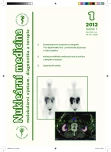Somatostatin receptor scintigraphy - 99mTc-EDDA/HYNIC-TOC first clinical experience in the Czech Republic
Authors:
Kateřina Táborská
Authors‘ workplace:
Klinika nukleární medicíny a endokrinologie 2. LF UK a FN Motol
Published in:
NuklMed 2012;1:7-12
Category:
Original Article
Overview
Introduction:
The aim of this article is to introduce the somatostatin analog EDDA/HYNIC-TOC labeled with 99mTechnetium available in Czech Republic since 2011. This radiopharmaceutical has been used for scintigraphic localisation of tumors bearing somatostatin receptors.
Material and methods:
We evaluated 18 patients in our department from September 2011. There were 3 pts with medullary thyroid cancer, 12 pts with neuroendocrine tumor (NET) or carcinoid, 2 pts with suspected carcinoid and 1 pt due to endocrine orbitopathy. Imaging consists of whole-body scan and SPECT/CT performed 4 hours post injection of 700 MBq of Tektrotyd. We add an abdominal SPECT 1 to 2 hours post injection.
Results:
Positive findings were detected in 6 pts. It was in agreement to other diagnostic methods. We detected accumulation in the suprarenal glands in 10 pts. This was not interpreted as a pathology, we believe this detection is thanks to a better resolution and an improved image quality. 12 pts were negative.
Conclusion:
99mTc EDDA/HYNIC-TOC (Tektrotyd) could be a good alternative to 111In-DTPA-D-Phe1-octreotide (Octreoscan) in evaluating patients with tumors bearing somatostatin receptors. Better availability, lower radiation and improved image quality are the advantage. Early tomographic imaging of abdomen should be done to avoid false positive findings due to nonspecific tracer accumulation.
Key Words:
neuroendocrine tumors, receptor scintigraphy, somatostatin
Sources
1. Krenning EP, Bakker WH, Kooij PPM et al. Somatostatin receptor scintigraphy with 111In-DTPA-D-PHE-1- octreotide in man: metabolism, dosimetry and comparison with [123I-Tyr-3-]-octreotide. J Nucl Med 1992;33:652-658
2. Krenning EP, Kwekkeboom DJ, Akker WH et al. Somatostatin receptor scintigraphy with [111In-DTPA-D-Phe1] - and [1231-Tyr3]-octreotide: the Rotterdam experience with more than 1000 patients. Eur J Nucl Med 1993;20:716-731
3. Zimmer T, Ziegler K, Bader M et al. Localization of neuroendocrine tumours of the upper gastrointestinal tract. Gut 1994;35:471–475
4. Decristoforo C, Mather SJ, Cholewinski W et al. 99mTc-EDDA/HYNIC-TOC: a new 99mTc-labelled radiopharmaceutical for imaging somatostatin receptor-positive tumours: first clinical results and intra-patient comparison with 111In-labelled octreotide derivatives. Eur J Nucl Med. 2000;27:1318–1325
5. Gabriel M, Decristoforo C, Donnemiller E et al. An intrapatient comparison of 99mTc-EDTTA/HYNIC-TOC with 111In-DTPA-octreotide for diagnosis of somatostatin receptor-expressing tumors. J Nucl Med 2003;44:708-716
6. Reubi JC, Kvols L, Krenning EP et al. Distribution of somatostatin receptor in normal and tumour tissue. Metabolism 1990;30 (suppl 2):78–81
7. De Herder W, Hofland LJ, van der Lely AJ, Lamberts SWJ. Somatostatin receptors in gastroenteropancreatic neuroendocrine tumours. Endocrine-Related Cancer 2003;10:451–458
8. The SNM practice guideline Somatostatin Receptor Scintigraphy Version 2.0 [online]. 2011. [cit. 2012-01-16]. Dostupné na: http://interactive.snm.org/index.cfm?PageID=772
9. Van Cutsem E, Verslype CH. Emerging therapies for neuro- endocrine tumors. Annals of Oncology 2008;19:(Suplement 8)
Labels
Nuclear medicine Radiodiagnostics RadiotherapyArticle was published in
Nuclear Medicine

2012 Issue 1
Most read in this issue
- Somatostatin receptor scintigraphy - 99mTc-EDDA/HYNIC-TOC first clinical experience in the Czech Republic
- Neuroendocrine tumors
- Stress tests in nuclear cardiology
- Quality of stress tests performed for myocardial perfusion scintigraphy
